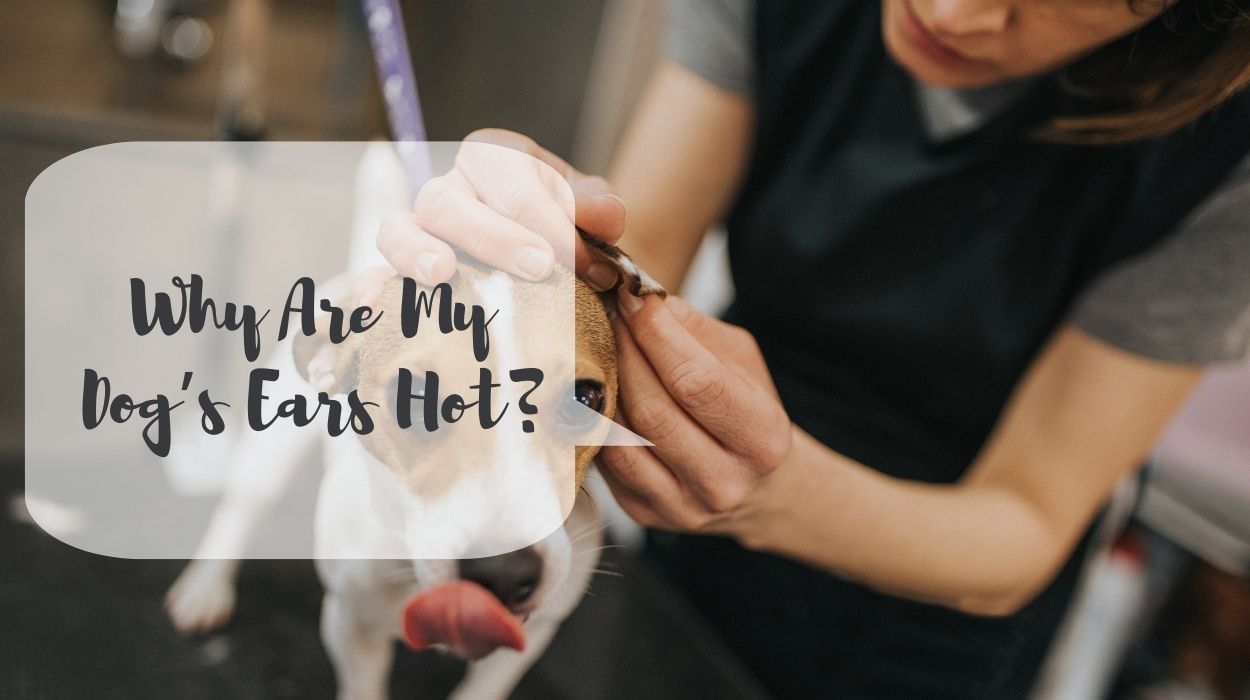With dogs being the best cuddle partners, letting go of any change unnoticed in their bodies is challenging.
You notice the ears are hotter than usual as you pet your dog. It’s very natural to ask yourself, If dogs’ ears are supposed to be warm, to what extent and how can we soothe them?
Dog’s ears can be hotter for various reasons, like an infection, fever, or even the weather!
This article will discuss all the possible reasons and when you should see the vet.
6 Reasons why your dog’s ears are hot

The ears of your dog are always going to be warmer than the temperature of your body! Once you learn this, you will know the difference between usual and unusual.
It’s different if your dog just had a good amount of playtime in the sun; his ears will be hotter than usual.
Apart from that, the following reasons erupt from the internal. Let’s have a look at them:
1. Are you protecting your dog’s paws
Well, you know the highly delicate part of your dog’s body is its paws, whole day they keep on waling running on uneven surfaces. Dogs have few sweat glands on their paws, so they might cool down, especially when walking on hot surfaces.
Even though God has created them so that they must, their bodies will become hotter if they happen to walk on hot surfaces!
It is one of the reasons why a dog’s ears feel hot after a good playtime outdoors.
2. Your dog can have a fever!
Hot ears are not the only indication of fever in your dog; for accurate determination, your dogs also need to show other signs of fever! For instance, in rage, your dog’s ears would get red and hot; also, his head, the side of his body, and back would feel warmer.
Since fever means that your dog’s body is trying to fight an infection or illness, the struggle doesn’t end here! Dogs are prone to colds and certain dog infections that cause fever.
So you don’t need to worry much if your dog is showing no other symptom, but his ears feel warm, as it is just a dog’s way to adjust to the temperature.
What are the other signs of fever in our dog?
- Red eyes, warm runny nose, and dry or heavy cough.
- Feeling tired or not will to move from a particular place.
- Dogs would refuse to eat or drink much
3. It can be heatstroke
Dog owners should be aware of heatstroke, especially at this time of year when the temperature rises. With the weather getting warmer and our dogs doing lots of activity outside, there could be heat emergencies, and it’s vital to get ahead of the signs and symptoms.
Here are seven signs that your dog might be suffering from heatstroke:
- Heavily breathing/ panting: as the temperature of your dog rises, they will open their mouth fully, sticking their tongue right out and panting heavily as they are overheating.
- Excessive drooling: extremely saliva helps the dog’s body calm down; as the body heats up, more saliva is produced, they are having a hard time keeping themselves cool.
- Dry red gums: when heatstroke is developing, the whole blood vessels on the outside of your dog will open up and dilate to lose heat as much as possible. Their gums will go from being moist to very tacky and dry. Your dog’s gums will turn from salmon pink to brick red in the heat; dehydration also becomes a genuine concern in hot weather, wildly when the dog is panting significantly; apart from that, your dog’s saliva will be very thick.
- Diarrhea and vomiting: Things have started getting very serious now; as the body’s insides heat up, the organs begin to struggle, the intestine line starts to damage, leading to vomiting and diarrhea. Your dog might vomit fresh blood and black stool as the condition worsens.
- Nervous signs: in this last and final stage, your dog might stop responding; they can be twitching or experiencing seizures.
Did you know studies show that dogs with heatstroke whose owners cool had a 38 percent chance of dying, and that’s compared to a 61 percent chance of dying in those dogs whose owners did not cool?
So, if any of these symptoms are visible in your dog, stop all you are doing and try to cool your dog until your veterinarian shows up.
Six practical steps to cool down your heat stroking dog:
- Try giving more water to your dog.
- Make sure he’s under a cool or shady spot.
- Soak their coat with tepid or lukewarm water, using a spray bottle or making them stand in a stream, lake, or bathtub.
- Blow air over your dog using a fan, open up the window if you are in a car.
- Apply an ice pack to their groin, armpits, and neck side.
- Put a wet towel over your dog.
4. Ear mites
Can you see a dark discharge and red bumps in and around your dog’s ears, followed by a powerful odor? Well, that’s how ear mites in dogs seem to be! Ear mites could be a genuine reason for your dog’s ears getting hot.
You can’t see mites with your naked eyes, but if you observe your dog’s action, you can spot it out because they make it very prominent by scratching and shaking their head more than usual.
How do dogs get ear mites?
Well, if you live with multiple pets, then It’s very likely for them to get exposed to this infection; mites take quite a long to develop; firstly, they lay eggs in your dog’s ears and take almost three weeks to become adult mites.
Over the period, you can see the changes in your dog’s hot ears, which is one of the prominent symptoms of this ear infection.
Taking your dog to the vet for early diagnosis is the key! The vet will mostly prescribe a dog ear cleaner.
If you allow an ear infection to progress, a total breakdown of the immunity system could occur.
Did you know if it’s summer season, you should be careful about leaving your dog out in the garden because that’s the time of ear when dogs are mostly affected with ear mites due to the grass pollen found here and there!
5. Your dog can have an ear infection
Before we get started on an ear infection, let me tell you it’s so common in dogs! The three things that contribute to this infection are yeast infection, ear mites, or bacteria. You need your vet to find out which one is it that’s causing trouble to your poor baby!
Sometimes only one ear of your dog might feel hot, but that doesn’t mean the infection is in just one ear! You will know when to take your dog to the vet.
One if you think that the ears of your dog are hot, then sit and observe if they show other signs or not; these signs are:
- Odor
- The skin around the ears is red
- Swelling
- Extremely scratching
- Head shaking
- Visible discharge from ears
- Circling
- Not responding to your commands effectively (hear loss)
There are many reasons for your dog to suffer from an ear infection like food and environmental allergies, water in the ear canals, Foreign bodies in the ear passages, wax build-up, and hyperthyroidism.
Keeping your dog healthy requires proper grooming. To save your expensive trips to the vet, it’s best if you start taking care of your dog’s ears! Hot ears can indicate such issues, and you should not ignore them.
Warning: Avoid cleaning your dog’s ears with any DIY solutions without the vets’ approval.
6. Dog Allergies
Now, the exciting part is 90% of the time, and your dog might develop allergies due to the food. Before being sure, you need to feel your dog’s ears right after he’s done having a meal! Again, the hot ears of your dog can be such a good indicator for allergies in them.
Apart from hot ears, the most common clinical signs of allergies in dogs are:
- Ear infections
- Scratching
- Hair loss
- Itching
- Redness
- Paw licking
- Excessive licking
- Vomiting
- Diarrhea
- Eye infections
However, never confuse food allergies with food sensitivity; a more immediate immunological response is seen in food allergies; dermatological signs include hives, swelling, and itching of the face.
On the other hand, food sensitivity is not life-threatening but can mess up with the stomach and face of your dog, for example, vomiting, diarrhea, itchy coat, redness, etc.
So please consult your vet to find out the actual reason; he might ask you to change your dog’s diet or medication.
How normal is it for dogs to feel hot?

Yes, it is because the average body temperature of dogs ranges between 101 and 102.5 F, which is more than humans, 97.6 to 99.6 F. in simple words, what’s warm for you is normal for dogs.
You should know the difference between hot vs. warm, it’s very essential as there’s a fragile line between. You can always check your dog’s temperature at home to avoid confusion.
Dogs pant a lot, especially during the hot weather; this is because they don’t have many sweat glands, that’s why they must regulate the temperature.
Apart from that, there are various reasons your dog feels hot without, like he just came home after playing a lot in the sun, exercising, a poop, or pee walk in the scorching sun!
However, if your dog shows physical discomfort like vomiting, lethargy, and loose motions, you should take him to the vet.
Is it possible to determine whether my dog has a fever without a thermometer?
Usually, veterinary clinics are the places to detect if your dog has a fever; you can’t do it at home!
The main reason is some dogs and not very welcoming to the idea of inserting something foreign in their rectum, and they might protest.
The second thing is it’s the work of two people; one should keep the dog calm while the other one is working on the end!
But it is possible to check if your dog has a fever or not without the help of a thermometer, so yes, you can also do it at home.
Symptoms of a feverish dog:
- Shivering
- Vomiting
- Lethargy
- Diarrhea
- Loss of appetite
- Red eyes
Step by step checking your dog:

- Dogs have a higher temperature than humans, so you should know how their average temperature would feel! Check the ears and paws of your dog; if they are hotter than usual, it could be due to a fever.
- If your pet’s gums are red, it means that he has a fever! A healthy dog’s gums usually appear pink.
- The nasal discharge of your dog would appear in green or yellow color sometimes. When a dog suffers from an infection, he can get a fever.
- Lay your dog on his back to feel the armpits and groin area, and if they feel swollen or hot, your dog has a fever.
- Fever in dogs is typically caused by one of four things: inflammation, infection, immune-mediated, or malignancy. Fever in dogs is treated differently depending on the reason. The fever can last for hours to a week, depending on the severity.
What is the ideal temperature for your pup’s ears?
Since we know that the temperature of dogs’ bodies is slightly higher than the temperature of humans, what’s normal for your dog might be not so typical for you.
But once you get habitat with the average temperature of your dog’s ears, it would be easy to distinguish between warm and hot!
Don’t get confused; if you feel that your dog’s ears are hotter than usual, check his temperature; it should be between 99.5-102.5 degrees Fahrenheit; anything above that indicates fever!
Are you scared or a new pet parent who doesn’t know how to check their dog’s temperature? Don’t be scared we will help you; also, you should be learning how to do it because not every time you can go rush to the vet straight away whenever your dogs exhibit symptoms of illness!
How to check your dog’s temperature in 5 easy steps:

Note: Take a special digital rectal probe or a rectal probe, and both work fine; for lube, you can use petroleum jelly or baby oil.
- No matter what, never skip reading the instructions, as they assure your dog is as safe and comfortable as possible throughout each use. It can also assist you in adjusting settings, such as obtaining temperature data in Celsius or Fahrenheit.
- Apply the lube to the end of the probe.
- Hold your dog still, and you can take the help of someone if it’s your first time.
- Distract your dog and lift his tail; insert 1–2 inches (2.5–5.1 cm) into the dog’s rectum.
- The thermometer will beep after they have finished doing the work; you must wait for at least 1-2 minutes.
Read the temperature:
An average dog’s temperature: 99.5–102.5 °F (37.5–39.2 °C); if it’s higher or lower than this, take your dog to the vet.
Warning: if your dog is being aggressive and showing zero tolerance, you should drop the idea of taking his temperature.
Last option: When should you take your dog to the vet?
If your dog’s ears feel hot and show no other symptoms, then maybe it’s due to natural changes in the environment, but if he’s showing signs of discomfort, you need to watch out for more. The best way is to take your dog’s temperature; if it goes above 104 degrees Fahrenheit, it’s time to rush to the vet.
If your dog’s temperature is above 102 degrees Fahrenheit, you can call the vet; he will help you cool down your dog for precautionary measures.
Conclusion
Your dog’s ears can tell a lot about his body, just like his tail is a good indicator of his happiness!
A healthy dog’s ears should be warm, not too hot or cold, as coldness indicates that you need to wrap him into a blanket like a burrito, and too much hotness suggests different types of infections, allergies, fever, etc.!
However, we hope that you know now how to detect any of the above! And when to see a vet. Did you know that ear issues are the most common reasons a dog visits the vet?
Once your dog gets cured of the case, you should take excellent care of the ears.

Dr. Aram Baker has been with Santa Clarita Animal Hospital since 1995 and his special interests include behaviour medicine and dermatology. He graduated from the Cleveland Humanities Magnet Program in Reseda, CA and attended California State University at Northridge where he received a Bachelor’s degree in biology. He went on to pursue his Doctorate in Veterinary Medicine at the University of California at Davis. He also spent time in the zoological medicine department at U.C. Davis during his Junior and Senior years. He is dedicated to caring for all pets big or small, young or old with compassion, patience, kindness, and love.
